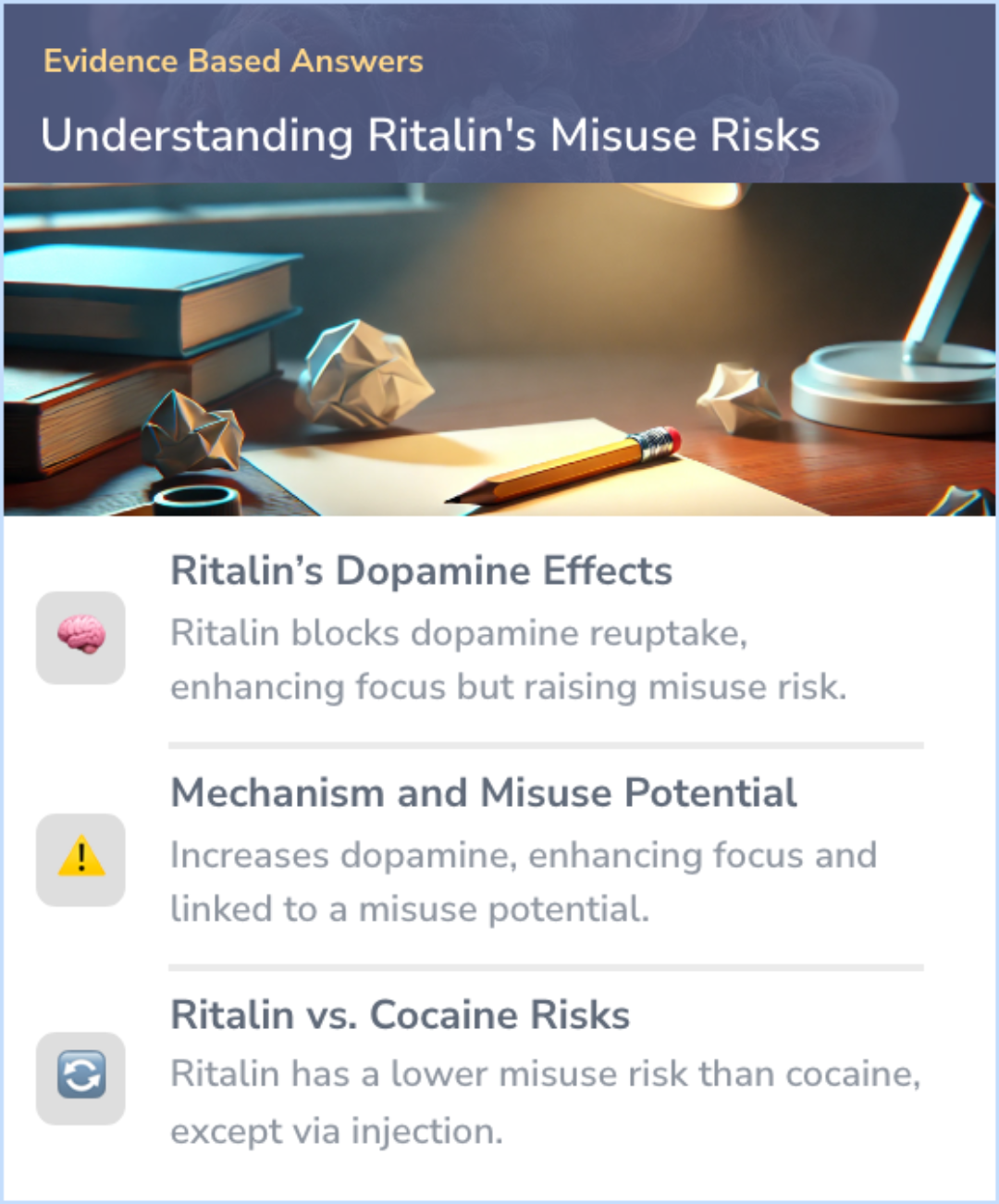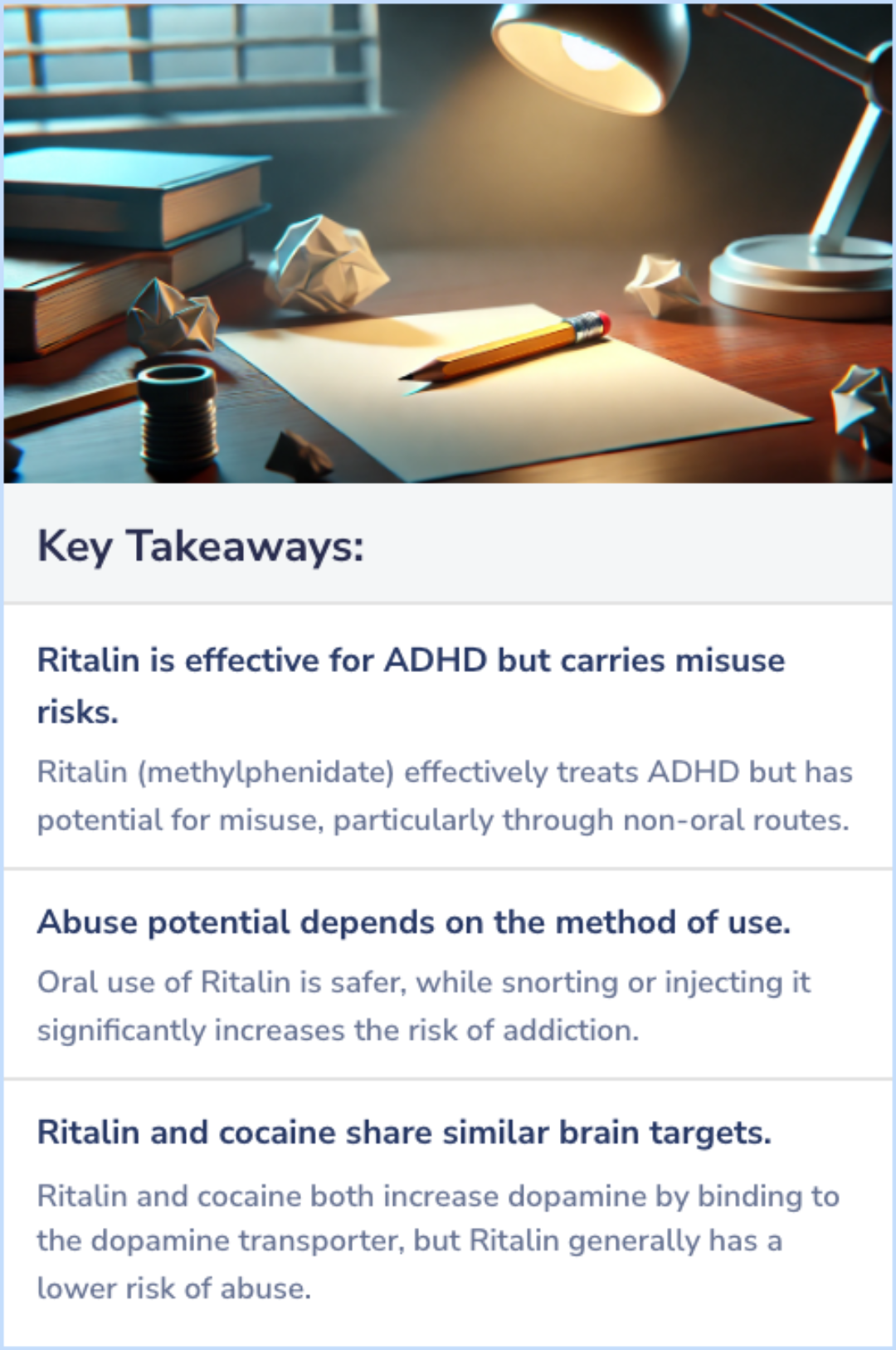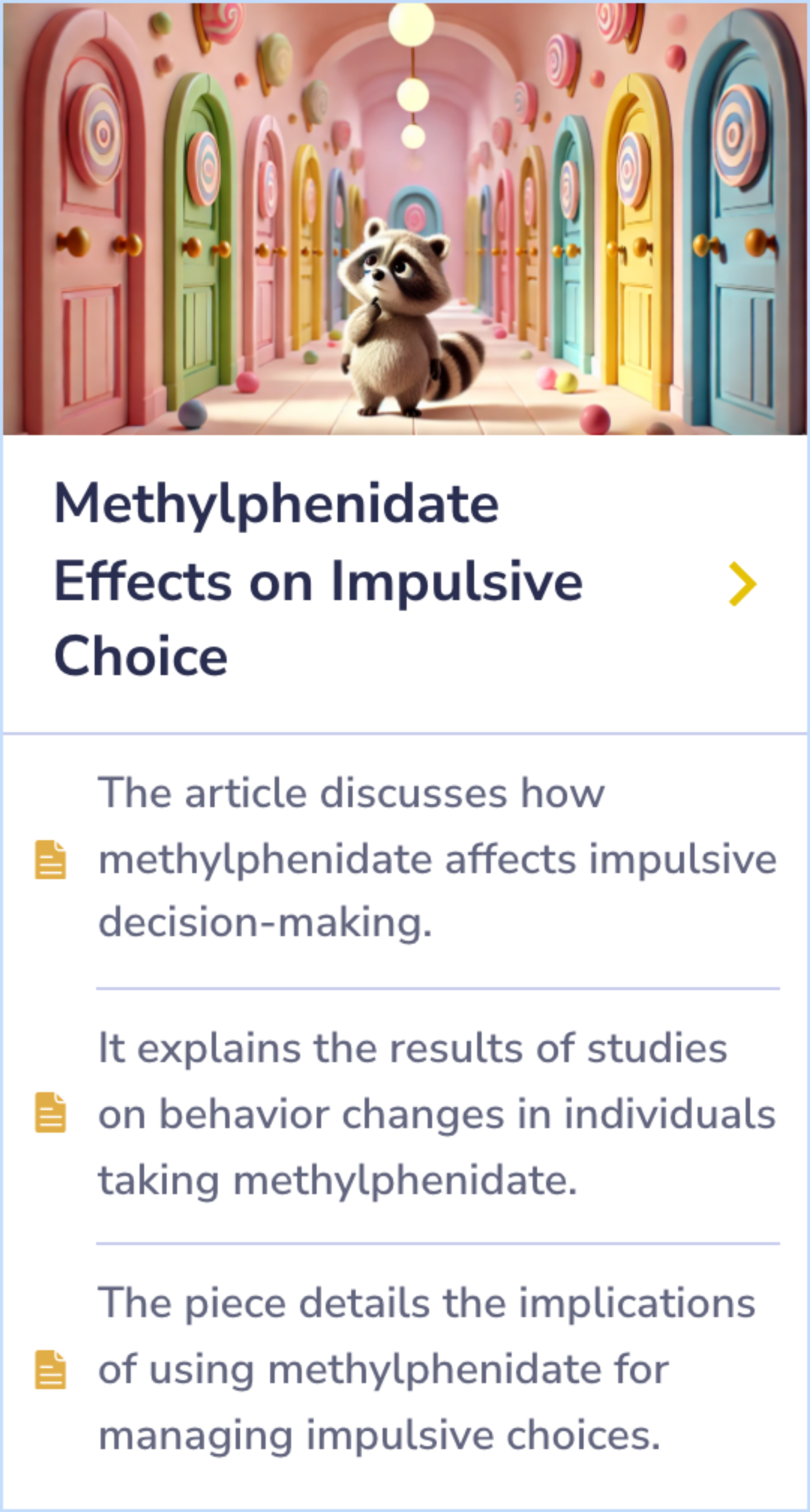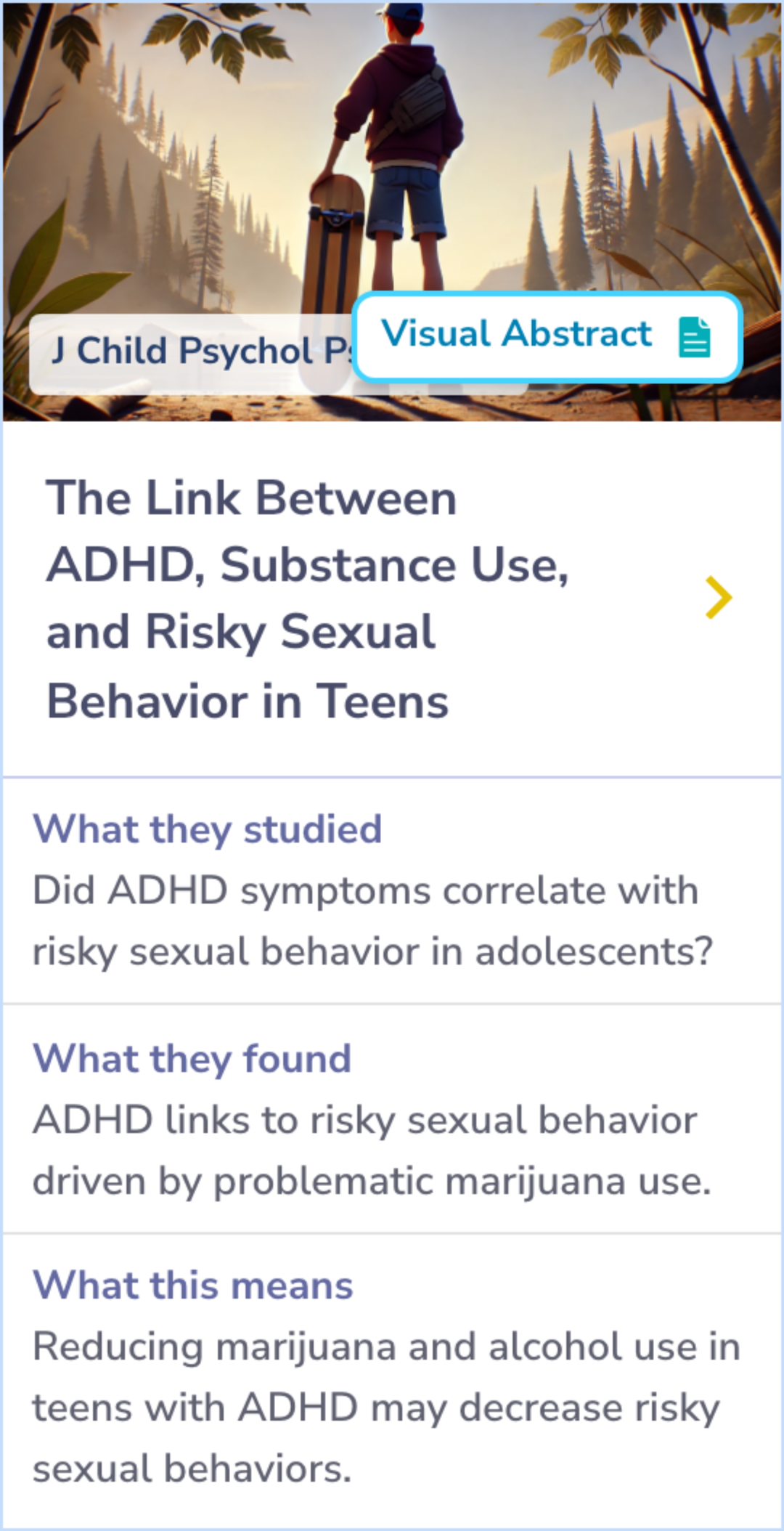Ritalin
Evidence Based Answers
The Abuse Potential of Ritalin (methylphenidate)
Ritalin boosts focus by raising dopamine levels but carries a misuse risk, especially through non-oral routes. Despite similarities to cocaine, misuse risks differ by intake method.
Published: October 25, 2024
Click to explore a section:

Ritalin’s dopamine effects can lead to misuse, especially in non-oral forms.
Understanding Ritalin's Benefits and Risks
Ritalin, also known as methylphenidate, is a stimulant commonly prescribed for ADHD and narcolepsy. It works by blocking the reuptake of dopamine in the brain, which helps improve focus and attention. According to the FDA, methylphenidate has been approved for treating these conditions. While effective, it's important to recognize the risk of misuse, particularly when the medication is not taken as prescribed, as this can lead to adverse effects.
“
Source Quotes:
The FDA has approved methylphenidate for treating ADHD and narcolepsy.
Psychostimulants, including methylphenidate (MPH), are the mainstay of pharmacotherapy for ADHD in adults.
How Ritalin Works and Misuse Potential
Ritalin (methylphenidate) increases dopamine levels in the brain by blocking its reuptake at the dopamine transporter. This process helps enhance focus and reduce hyperactivity in people with ADHD. The drug's mechanism of action primarily affects key dopaminergic areas of the brain. However, the same mechanism that improves focus can also make the drug prone to misuse due to the pleasurable feelings associated with increased dopamine levels.
“
Source Quotes:
Methylphenidate binds to the dopamine transporter...blocking reuptake of dopamine.
Methylphenidate acts primarily as a dopamine (DA) reuptake inhibitor.
Ritalin vs. Cocaine: Understanding Abuse Potential
Both Ritalin and cocaine bind to the dopamine transporter in the brain, but Ritalin typically presents a lower risk of abuse. When administered intravenously, Ritalin can produce euphoria similar to cocaine, though this is less common due to differences in how the drugs are usually taken. Despite the potential for abuse, Ritalin's pharmacological properties generally make it less likely to be misused compared to cocaine.
“
Source Quotes:
Methylphenidate and cocaine both bind to the dopamine transporter...When given intravenously, methylphenidate can induce a sensation of euphoria...methylphenidate has a much lower abuse potential than cocaine.
Assess the risk of abuse before prescribing methylphenidate in any form.
Oral Use of Ritalin and Its Safer Profile
When taken orally as prescribed, Ritalin enters the bloodstream slowly, which reduces the likelihood of euphoria and addiction. This method of administration is key to its safer use, as it lowers the potential for misuse compared to other routes of administration. Studies have shown that oral use of Ritalin in medically supervised contexts rarely leads to abuse.
“
Source Quotes:
Numerous studies in adults have shown no indication that the use of oral methylphenidate in the medically ill population leads to problems of abuse.
High-Risk Routes: Injecting and Snorting Ritalin
Ritalin can be abused through injection or snorting, methods that cause a rapid and intense effect on the brain. These routes of administration significantly increase the risk of addiction and other health complications, making them particularly dangerous forms of misuse. Intranasal or intravenous use of Ritalin is associated with higher risks compared to oral administration.
“
Source Quotes:
Methylphenidate has been abused both intravenously and intranasally.
Abuse by oral administration of methylphenidate is rare. When abused, methylphenidate is usually administered intranasally or injected intravenously.
Key Takeaways
Conclusions
Ritalin (methylphenidate) is a stimulant medication that can be highly effective in treating ADHD and narcolepsy, particularly when taken as prescribed. However, its ability to increase dopamine levels, which improves focus and attention, also carries a risk of misuse.
While Ritalin has a lower abuse potential than substances like cocaine, especially when taken orally, alternative routes such as snorting or injecting significantly elevate the risks of addiction and adverse effects. Responsible use under medical supervision is crucial to minimizing these dangers.
While Ritalin has a lower abuse potential than substances like cocaine, especially when taken orally, alternative routes such as snorting or injecting significantly elevate the risks of addiction and adverse effects. Responsible use under medical supervision is crucial to minimizing these dangers.

Evidence Summary
Methylphenidate's Effect on Impulsive Decisions
Methylphenidate impacts impulsive decision-making by altering behavior. Studies show significant changes in how individuals make choices while on this medication.
These findings highlight the effectiveness of methylphenidate in managing impulsive actions, providing insight into its role in behavior modification.
These findings highlight the effectiveness of methylphenidate in managing impulsive actions, providing insight into its role in behavior modification.
Evidence Summary
ADHD, Substance Use, and Risky Behavior in Teens
Researchers explored whether ADHD symptoms are linked to risky sexual behavior among adolescents, focusing on problematic substance use and conduct issues. They assessed ADHD symptoms, conduct problems, and substance use in 115 teens from the juvenile justice system. The link between ADHD and risky sexual behavior was found to be driven primarily by marijuana use, with alcohol playing a lesser role among those with high conduct problems.
ADHD's connection to risky sexual behavior was not influenced by conduct problems alone but was notably associated with marijuana use. This highlights the specific role of substance use in understanding the behaviors of teens with ADHD.
ADHD's connection to risky sexual behavior was not influenced by conduct problems alone but was notably associated with marijuana use. This highlights the specific role of substance use in understanding the behaviors of teens with ADHD.
Evidence Summary
Understanding Impulsivity and Its Link to Dopamine
Impulsivity often leads to actions like interrupting others or taking risks without considering the consequences. These behaviors are driven by changes in dopamine levels in the brain, which are also linked to addiction and eating disorders.
ADHD treatments focus on managing dopamine to reduce impulsivity, underscoring the role of dopamine in regulating such behaviors.
ADHD treatments focus on managing dopamine to reduce impulsivity, underscoring the role of dopamine in regulating such behaviors.


